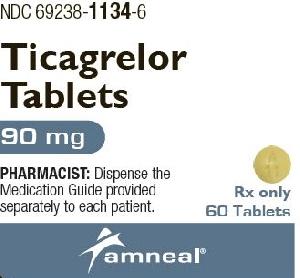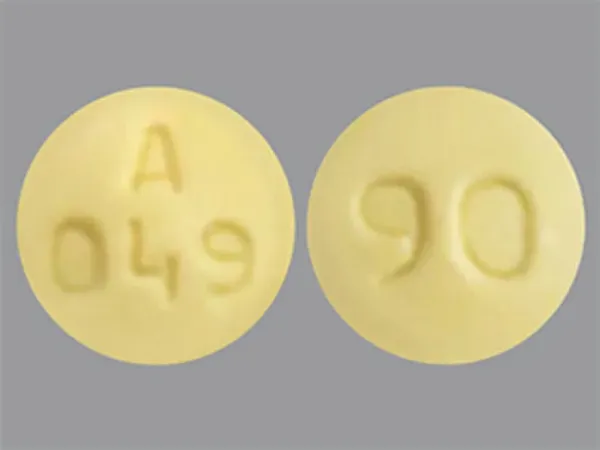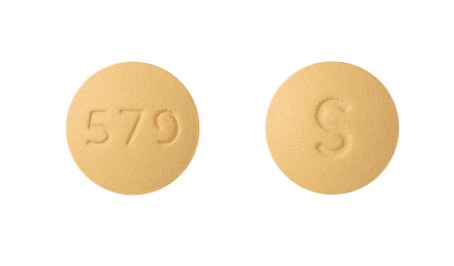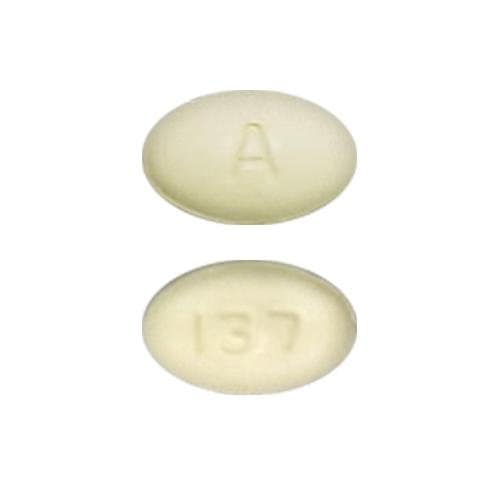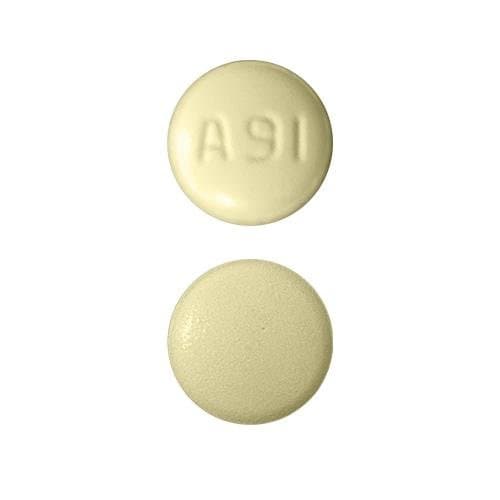Boxed Warning
Bleeding risk:
Ticagrelor, like other antiplatelet agents, can cause significant, sometimes fatal, bleeding.
Do not use ticagrelor in patients with active pathological bleeding or a history of intracranial hemorrhage.
Do not start ticagrelor in patients undergoing urgent coronary artery bypass graft (CABG) surgery.
If possible, manage bleeding without discontinuing ticagrelor. Stopping ticagrelor increases the risk of subsequent cardiovascular events.
Aspirin dose and ticagrelor effectiveness:
Maintenance doses of aspirin above 100 mg reduce the effectiveness of ticagrelor and should be avoided.
Dosage Forms
Excipient information presented when available (limited, particularly for generics); consult specific product labeling.
Tablet, Oral:
Brilinta: 60 mg, 90 mg
Pharmacology
Mechanism of Action
Reversibly and noncompetitively binds the adenosine diphosphate (ADP) P2Y12 receptor on the platelet surface which prevents ADP-mediated activation of the GPIIb/IIIa receptor complex thereby reducing platelet aggregation. Due to the reversible antagonism of the P2Y12 receptor, recovery of platelet function is likely to depend on serum concentrations of ticagrelor and its active metabolite.
Pharmacokinetics/Pharmacodynamics
Absorption
Rapid
Distribution
88 L
Metabolism
Hepatic via CYP3A4/5 to active metabolite (AR-C124910XX)
Excretion
Feces (58%); urine (26%); actual amount of parent drug and active metabolite excreted in urine was <1% of total dose administered.
Onset of Action
Inhibition of platelet aggregation (IPA): 180 mg loading dose: ~41% within 30 minutes (similar to clopidogrel 600 mg at 8 hours); Peak effect: Time to maximal IPA: 180 mg loading dose: IPA ~88% at 2 hours post administration
Time to Peak
Whole tablets: Parent drug: 1.5 hours (median; range: 1 to 4 hours); Active metabolite (AR-C124910XX): 2.5 hours (median; range: 1.5 to 5 hours)
Crushed tablets: Oral or nasogastric tube administration: Parent drug: ~1 hour (median; range: 1 to 4 hours); Active metabolite (AR-C124910XX): 2 hours (median; range: 1 to 8 hours). Note: Significantly higher concentrations of both ticagrelor and AR-C124910XX may appear at earlier time points (0.5 and 1 hour, respectively) when administered as crushed tablets (Teng 2015).
Duration of Action
IPA: 180 mg loading dose: 87% to 89% maintained from 2 to 8 hours; 24 hours after the last maintenance dose, IPA is 58% (similar to maintenance dosing for clopidogrel)
Time after discontinuation when IPA is 30%: ~56 hours; IPA 10%: ~110 hours (Gurbel 2009). Mean IPA observed with ticagrelor at 3 days post-discontinuation was comparable to that observed with clopidogrel at 5 days post discontinuation.
Half-Life Elimination
Parent drug: ~7 hours; active metabolite: ~9 hours
Protein Binding
>99% (parent drug and active metabolite)
Use in Specific Populations
Special Populations: Renal Function Impairment
AUC and Cmax were 38% and 51% higher, respectively, in patients with ESRD on hemodialysis compared to patients with normal renal function following a single 90 mg dose of ticagrelor administered on a nondialysis day; similar exposure was observed when administered immediately prior to dialysis. Inhibition of platelet aggregation was independent of dialysis and similar to healthy adults with normal renal function.
Special Populations Note
Cigarette smoking: Mean clearance was increased by approximately 22% in smokers.
Use: Labeled Indications
Acute coronary syndrome: Reduction of the rate of cardiovascular death, myocardial infarction (MI), and stroke in patients with acute coronary syndrome (ACS) or a history of MI. Ticagrelor also reduces the rate of stent thrombosis in patients who have been stented for treatment of ACS.
Use: Off Label
Non-ST-elevation acute coronary syndrome, aspirin intolerant patientsyes
Based on the American Heart Association/American College of Cardiology (AHA/ACC) guidelines for the management of patients with non-ST-elevation acute coronary syndromes (NSTE-ACS), ticagrelor is a reasonable alternative to aspirin in aspirin intolerant patients even though it has not been studied in the absence of aspirin.
Contraindications
Hypersensitivity (eg, angioedema) to ticagrelor or any component of the formulation; active pathological bleeding (eg, peptic ulcer, intracranial hemorrhage); history of intracranial hemorrhage
Canadian labeling: Additional contraindications (not in US labeling): Moderate to severe hepatic impairment; concomitant use of strong CYP3A4 inhibitors (eg, ketoconazole, clarithromycin, ritonavir, atazanavir, nefazodone)
Dosage and Administration
Dosing: Adult
Acute coronary syndrome (ACS): Non-ST-elevation acute coronary syndromes (NSTE-ACS), ST-segment elevation myocardial infarction (STEMI): Oral, NG: Initial: 180 mg loading dose (with a loading dose of aspirin [eg, 325 mg] if not already receiving); Maintenance: 90 mg twice daily; initiated 12 hours after initial loading dose with low-dose aspirin 75 to 100 mg/day or 81 mg/day indefinitely in patients with NSTE-ACS or STEMI as recommended by ACCF/AHA/SCAI). Continue initial therapy with ticagrelor for up to 12 months. After 12 months of initial therapy, reduce ticagrelor dose to 60 mg twice daily. Patients in the clinical trial were followed up over a period of 3 years (Bonaca 2015).
Duration of ticagrelor (in combination with aspirin) after stent placement: Premature interruption of therapy may result in stent thrombosis with subsequent fatal and nonfatal MI. According to the ACC/AHA Duration of Dual Antiplatelet Therapy (DAPT) guidelines, at least 12 months of a P2Y12 inhibitor (eg, ticagrelor) is recommended for those with ACS receiving either stent type (bare metal [BMS] or drug eluting stent [DES]). The DAPT score (https://tools.acc.org/DAPTriskapp/#!/content/calculator/) may be useful in determining whether to prolong or extend DAPT in patients with stent placement (Yeh 2016). In addition, in patients with DES placement with a high risk of bleeding or significant overt bleeding on DAPT, it may be reasonable to discontinue ticagrelor after 6 months of therapy instead (ACC/AHA [Levine 2016]).
Conversion from clopidogrel to ticagrelor: May initiate ticagrelor 90 mg twice daily beginning 24 hours after last clopidogrel dose (loading or maintenance). Patients who are in the acute phase of an acute coronary syndrome, especially if determined to be clopidogrel nonresponsive, may be considered for administration of ticagrelor 180 mg loading dose followed by 90 mg twice daily regardless of previous clopidogrel exposure, taking into consideration the administration of other antiplatelet agents (eg, GP IIb/IIIa inhibitors) (Gurbel 2010; Wallentin 2009). In one single blinded study, patients with ACS receiving ongoing clopidogrel treatment who were converted to ticagrelor without a loading dose did not experience a reduction in platelet inhibition compared to those who received a loading dose of ticagrelor (Caiazzo 2014). Note: In general, conversion to ticagrelor results in an absolute inhibition of platelet aggregation (IPA) increase of 26.4%.
Dosing: Geriatric
Refer to adult dosing.
Extemporaneously Prepared
A suspension for oral administration may be prepared by crushing one or two 90 mg tablets in a mortar (for 60 seconds) and placing in a dosing cup. To ensure the full dose is received, rinse mortar with 100 mL purified water, transfer to dosing cup, and repeat rinse (Crean, 2013; Parodi, 2015).
A suspension for NG tube administration may be prepared by crushing one or two 90 mg tablets in a mortar (for 60 seconds); add 50 mL purified water to mortar and stir (for 60 seconds); transfer the suspension to a 50 mL oral enteral syringe and administer via NG tube. To ensure the full dose is received, add another 50 mL purified water to the mortar and stir for 60 seconds; using the same 50 mL oral enteral syringe, withdraw the suspension and administer entire amount via NG tube (Crean, 2013).
When stored in a PVC oral syringe for up to 2 hours, there was no degradation of the suspension detected (Crean, 2013).
Administration
Administer with or without food. Missed doses should be taken at their next regularly scheduled time. For patients unable to swallow whole, tablets may be crushed and mixed with water to create a suspension for oral or NG (CH8/Fr8 or greater according to the manufacturer) use. If suspension is administered orally, refill glass with water, stir and drink; if administered via NG tube, flush NG tube through with water after administration (Crean, 2013; Parodi, 2015). Administration of crushed tablets, while bioequivalent to administration of whole tablets, may result in increased concentrations of ticagrelor and the major active metabolite at earlier time points (Teng 2015).
Storage
Store at 25°C (77°F); excursions permitted to 15°C to 30°C (59°F to 86°F).
Ticagrelor Images
Drug Interactions
Acalabrutinib: May enhance the antiplatelet effect of Agents with Antiplatelet Properties. Monitor therapy
Agents with Antiplatelet Properties (e.g., P2Y12 inhibitors, NSAIDs, SSRIs, etc.): May enhance the antiplatelet effect of other Agents with Antiplatelet Properties. Monitor therapy
Anticoagulants: Agents with Antiplatelet Properties may enhance the anticoagulant effect of Anticoagulants. Exceptions: Bemiparin; Enoxaparin; Heparin. Monitor therapy
Apixaban: Antiplatelet Agents (P2Y12 Inhibitors) may enhance the adverse/toxic effect of Apixaban. Specifically, the risk for bleeding may be increased. Management: Carefully consider risks and benefits of this combination and monitor closely; Canadian labeling recommends avoiding prasugrel or ticagrelor. Consider therapy modification
Aspirin: May enhance the antiplatelet effect of Ticagrelor. Aspirin may diminish the therapeutic effect of Ticagrelor. More specifically, the benefits of ticagrelor relative to clopidogrel may be diminished in adult patients receiving daily aspirin doses greater than 100-150 mg daily. Management: Avoid daily aspirin doses greater than 100 mg in adults receiving ticagrelor. Canadian recommendations are to avoid adult daily aspirin doses greater than 150 mg. Daily low-dose aspirin (U.S.: 75-100 mg; Canada: 75-150 mg) is recommended. Consider therapy modification
AtorvaSTATin: Ticagrelor may increase the serum concentration of AtorvaSTATin. Monitor therapy
Bemiparin: Agents with Antiplatelet Properties may enhance the anticoagulant effect of Bemiparin. Management: Avoid concomitant use of bemiparin with antiplatelet agents. If concomitant use is unavoidable, monitor closely for signs and symptoms of bleeding. Consider therapy modification
Bosentan: May decrease the serum concentration of CYP3A4 Substrates (High risk with Inducers). Monitor therapy
Cephalothin: Agents with Antiplatelet Properties may enhance the adverse/toxic effect of Cephalothin. Specifically, the risk for bleeding may be increased. Monitor therapy
Collagenase (Systemic): Agents with Antiplatelet Properties may enhance the adverse/toxic effect of Collagenase (Systemic). Specifically, the risk of injection site bruising and/or bleeding may be increased. Monitor therapy
CycloSPORINE (Systemic): May increase the serum concentration of Ticagrelor. Monitor therapy
CYP3A4 Inducers (Moderate): May decrease the serum concentration of CYP3A4 Substrates (High risk with Inducers). Monitor therapy
CYP3A4 Inducers (Strong): May decrease serum concentrations of the active metabolite(s) of Ticagrelor. CYP3A4 Inducers (Strong) may decrease the serum concentration of Ticagrelor. Avoid combination
CYP3A4 Inhibitors (Moderate): May increase the serum concentration of Ticagrelor. Monitor therapy
CYP3A4 Inhibitors (Strong): May decrease serum concentrations of the active metabolite(s) of Ticagrelor. CYP3A4 Inhibitors (Strong) may increase the serum concentration of Ticagrelor. Avoid combination
Dabigatran Etexilate: Ticagrelor may enhance the anticoagulant effect of Dabigatran Etexilate. Ticagrelor may increase the serum concentration of Dabigatran Etexilate. Management: Carefully consider the anticipated risks and benefits of this combination. Increase monitoring for evidence of bleeding if these agents are combined and consider avoiding the use of this combination in the presence of reduced renal function. Consider therapy modification
Dabrafenib: May decrease the serum concentration of CYP3A4 Substrates (High risk with Inducers). Management: Seek alternatives to the CYP3A4 substrate when possible. If concomitant therapy cannot be avoided, monitor clinical effects of the substrate closely (particularly therapeutic effects). Consider therapy modification
Dasatinib: May enhance the anticoagulant effect of Agents with Antiplatelet Properties. Management: Drugs listed as exceptions to this monograph are discussed in further detail in separate drug interaction monographs. Monitor therapy
Deferasirox: May decrease the serum concentration of CYP3A4 Substrates (High risk with Inducers). Monitor therapy
Deoxycholic Acid: Agents with Antiplatelet Properties may enhance the adverse/toxic effect of Deoxycholic Acid. Specifically, the risk for bleeding or bruising in the treatment area may be increased. Monitor therapy
Digoxin: Ticagrelor may increase the serum concentration of Digoxin. Monitor therapy
Edoxaban: Antiplatelet Agents (P2Y12 Inhibitors) may enhance the adverse/toxic effect of Edoxaban. Specifically, the risk of bleeding may be increased. Management: Carefully consider the anticipated risks and benefits of this combination. If combined, increased monitoring for bleeding is recommended. Consider therapy modification
Enoxaparin: Agents with Antiplatelet Properties may enhance the anticoagulant effect of Enoxaparin. Management: Discontinue antiplatelet agents prior to initiating enoxaparin whenever possible. If concomitant administration is unavoidable, monitor closely for signs and symptoms of bleeding. Consider therapy modification
Erdafitinib: May decrease the serum concentration of CYP3A4 Substrates (High risk with Inducers). Monitor therapy
Fat Emulsion (Fish Oil Based): May enhance the adverse/toxic effect of Agents with Antiplatelet Properties. Monitor therapy
FentaNYL: May diminish the antiplatelet effect of Antiplatelet Agents (P2Y12 Inhibitors). FentaNYL may decrease the serum concentration of Antiplatelet Agents (P2Y12 Inhibitors). Monitor therapy
Glucosamine: May enhance the antiplatelet effect of Agents with Antiplatelet Properties. Monitor therapy
Grapefruit Juice: May increase the serum concentration of Ticagrelor. Monitor therapy
Heparin: Agents with Antiplatelet Properties may enhance the anticoagulant effect of Heparin. Management: Decrease the dose of heparin or agents with antiplatelet properties if coadministration is required. Consider therapy modification
Herbs (Anticoagulant/Antiplatelet Properties) (eg, Alfalfa, Anise, Bilberry): May enhance the adverse/toxic effect of Agents with Antiplatelet Properties. Bleeding may occur. Management: Avoid combination when possible. If used, monitor more closely for evidence of bleeding. Discontinue herbal products with anticoagulant or antiplatelet actions 2 weeks prior to surgical, dental, or invasive procedures. Consider therapy modification
Ibritumomab Tiuxetan: Agents with Antiplatelet Properties may enhance the adverse/toxic effect of Ibritumomab Tiuxetan. Both agents may contribute to impaired platelet function and an increased risk of bleeding. Monitor therapy
Ibrutinib: May enhance the adverse/toxic effect of Agents with Antiplatelet Properties. Monitor therapy
Inotersen: May enhance the antiplatelet effect of Agents with Antiplatelet Properties. Monitor therapy
Ivosidenib: May decrease the serum concentration of CYP3A4 Substrates (High risk with Inducers). Monitor therapy
Limaprost: May enhance the antiplatelet effect of Agents with Antiplatelet Properties. Monitor therapy
Lorlatinib: May decrease the serum concentration of CYP3A4 Substrates (High risk with Inducers). Management: Avoid concurrent use of lorlatinib with any CYP3A4 substrates for which a minimal decrease in serum concentrations of the CYP3A4 substrate could lead to therapeutic failure and serious clinical consequences. Consider therapy modification
Lovastatin: Ticagrelor may increase the serum concentration of Lovastatin. Management: Avoid using doses of lovastatin greater than 40 mg/day with ticagrelor. This specific recommendation is found in the U.S. prescribing information but not in the Canadian product monograph. Consider therapy modification
Morphine (Systemic): May diminish the antiplatelet effect of Antiplatelet Agents (P2Y12 Inhibitors). Morphine (Systemic) may decrease the serum concentration of Antiplatelet Agents (P2Y12 Inhibitors). Management: Consider alternative anti-ischemic/analgesic therapies (eg, beta-blockers, nitroglycerin) in patients with acute coronary syndromes treated with a P2Y12 inhibitor when possible. The risks associated with other opioids are unknown. Consider therapy modification
Multivitamins/Fluoride (with ADE): May enhance the antiplatelet effect of Agents with Antiplatelet Properties. Monitor therapy
Multivitamins/Minerals (with ADEK, Folate, Iron): May enhance the antiplatelet effect of Agents with Antiplatelet Properties. Monitor therapy
Multivitamins/Minerals (with AE, No Iron): May enhance the antiplatelet effect of Agents with Antiplatelet Properties. Monitor therapy
Obinutuzumab: Agents with Antiplatelet Properties may enhance the adverse/toxic effect of Obinutuzumab. Specifically, the risk of serious bleeding-related events may be increased. Monitor therapy
Omega-3 Fatty Acids: May enhance the antiplatelet effect of Agents with Antiplatelet Properties. Monitor therapy
Pentosan Polysulfate Sodium: May enhance the adverse/toxic effect of Agents with Antiplatelet Properties. Specifically, the risk of bleeding may be increased by concurrent use of these agents. Monitor therapy
Pentoxifylline: May enhance the antiplatelet effect of Agents with Antiplatelet Properties. Monitor therapy
Prostacyclin Analogues: May enhance the antiplatelet effect of Agents with Antiplatelet Properties. Monitor therapy
Rivaroxaban: Antiplatelet Agents (P2Y12 Inhibitors) may enhance the adverse/toxic effect of Rivaroxaban. Specifically, the risk of bleeding may be increased. Management: Carefully consider risks and benefits of this combination and monitor closely; Canadian labeling recommends avoiding prasugrel or ticagrelor. Consider therapy modification
Salicylates: Agents with Antiplatelet Properties may enhance the adverse/toxic effect of Salicylates. Increased risk of bleeding may result. Monitor therapy
Sarilumab: May decrease the serum concentration of CYP3A4 Substrates (High risk with Inducers). Monitor therapy
Siltuximab: May decrease the serum concentration of CYP3A4 Substrates (High risk with Inducers). Monitor therapy
Simvastatin: Ticagrelor may increase the serum concentration of Simvastatin. Management: Avoid using doses of simvastatin greater than 40 mg/day with ticagrelor. This specific recommendation is found in the U.S. prescribing information but not in the Canadian product monograph. Consider therapy modification
Thrombolytic Agents: Agents with Antiplatelet Properties may enhance the anticoagulant effect of Thrombolytic Agents. Monitor therapy
Tipranavir: May enhance the antiplatelet effect of Agents with Antiplatelet Properties. Monitor therapy
Tocilizumab: May decrease the serum concentration of CYP3A4 Substrates (High risk with Inducers). Monitor therapy
Urokinase: Agents with Antiplatelet Properties may enhance the anticoagulant effect of Urokinase. Avoid combination
Vitamin E (Systemic): May enhance the antiplatelet effect of Agents with Antiplatelet Properties. Monitor therapy
Zanubrutinib: May enhance the antiplatelet effect of Agents with Antiplatelet Properties. Monitor therapy
Test Interactions
False-negative results for the platelet activation functional assay to diagnose heparin-induced thrombocytopenia may occur via plasma ticagrelor inhibition of P2Y12-receptors on healthy donor platelets, which are added for the assay, reducing platelet activation and interfering with the results.
Adverse Reactions
As with all drugs which may affect hemostasis, bleeding is associated with ticagrelor. Hemorrhage may occur at virtually any site. Risk is dependent on multiple variables, including the concurrent use of multiple agents which alter hemostasis and patient susceptibility.
>10%: Respiratory: Dyspnea (14%)
1% to 10%:
Cardiovascular: ECG abnormality (ventricular pause; 2% to 6%), presyncope (≤2%), syncope (≤2%)
Central nervous system: Dizziness (5%), loss of consciousness (≤2%)
Gastrointestinal: Nausea (4%)
Hematologic & oncologic: Major hemorrhage (4%), minor hemorrhage (4%)
Renal: Increased serum creatinine (7%; transient; mechanism undetermined)
Frequency not defined: Endocrine & metabolic: Increased uric acid
<1%, postmarketing, and/or case reports: Angioedema, atrioventricular block, bradycardia, gout, hypersensitivity reaction, skin rash, thrombotic thrombocytopenic purpura (Wang 2018)
Warnings/Precautions
Concerns related to adverse effects:
- Bleeding: [US Boxed Warning]: Ticagrelor increases the risk of bleeding including significant and sometimes fatal bleeding. Use is contraindicated in patients with active pathological bleeding (eg, peptic ulcer bleeding, intracranial hemorrhage) or history of intracranial hemorrhage. Additional risk factors for bleeding include propensity to bleed (eg, recent trauma or surgery, recent or recurrent GI bleeding, active peptic ulcer disease (PUD), moderate to severe hepatic impairment), CABG or other surgical procedure, concomitant use of medications that increase risk of bleeding (eg, warfarin, nonsteroidal anti-inflammatory drugs), and advanced age. Bleeding should be suspected if patient becomes hypotensive after undergoing recent coronary angiography, percutaneous coronary intervention, CABG, or other surgical procedure even if overt signs of bleeding do not exist. Where possible, manage bleeding without discontinuing ticagrelor because the risk of cardiovascular events is increased upon discontinuation. If discontinuation of ticagrelor is necessary, resume as soon as possible after the bleeding source is identified and controlled. Hemostatic benefits of platelet transfusions are not known; may inhibit transfused platelets.
- Bradyarrhythmias: Ventricular pauses and bradyarrhythmias, including atrioventricular (AV) block, have been reported. Use with caution in patients with second- or third-degree AV block, sick sinus syndrome, bradycardia-related syncope not protected by a pacemaker, or patients taking other bradycardic-inducing agents (eg, beta blockers, nondihydropyridine calcium channel blockers). Ventricular pauses ≥3 seconds were noted more frequently with ticagrelor than with clopidogrel during the first week after hospitalization for acute coronary syndrome (ACS) in a substudy of the Platelet Inhibition and Patient Outcomes (PLATO) trial; however, most ventricular pauses were asymptomatic and transient (Scirica 2011).
- Hyperuricemia: Use with caution in patients with a history of hyperuricemia or gouty arthritis. Renal uptake and transport of uric acid are inhibited by ticagrelor and its active metabolite and the risk of hyperuricemia may be increased (Butler 2012; Zhang 2015). However, reports of gout did not differ between treatment groups in the PLATO trial.
- Respiratory: Dyspnea (often mild to moderate and transient) was observed more frequently in patients receiving ticagrelor compared to clopidogrel or aspirin alone during clinical trials (14% to 19% vs 6% to 8%) (Bonaca, 2015; Wallentin, 2009). Resolution of dyspnea was observed within 1 week in most patients (Wallentin 2009). Patients with new, prolonged, or worsening dyspnea should be evaluated to rule out underlying disease. Ticagrelor-related dyspnea does not require specific treatment nor does it warrant therapy interruption; however, therapy should be discontinued in patients unable to tolerate ticagrelor-related dyspnea.
- Thrombotic thrombocytopenic purpura: Cases of thrombotic thrombocytopenic purpura, some fatal, have been reported with ticagrelor; urgent treatment is required. Plasmapheresis should be considered (Doğan 2017; Wang 2018).
Disease-related concerns:
- Bleeding disorders: Use with caution in patients with platelet disorders, bleeding disorders, and/or at increased risk for bleeding (eg, PUD, trauma, surgery).
- Hepatic impairment: Use with caution in patients with moderate hepatic impairment (limited experience); avoid use in severe hepatic impairment (has not been studied).
- Renal impairment: Creatinine levels may rise during therapy (mechanism undetermined); monitor renal function.
Concurrent drug therapy issues:
- Aspirin/other NSAIDs: [US Boxed Warning]: Maintenance doses of aspirin >100 mg/day reduce the efficacy of ticagrelor and should be avoided. Use of higher maintenance doses of aspirin (ie, >100 mg/day) was associated with relatively unfavorable outcomes for ticagrelor versus clopidogrel in the PLATO trial (Gaglia, 2011; Wallentin, 2009).
- Drug-drug interactions: Potentially significant interactions may exist, requiring dose or frequency adjustment, additional monitoring, and/or selection of alternative therapy. Consult drug interactions database for more detailed information.
Special populations:
- Lower GI bleed patients: An individualized and multidisciplinary approach should be utilized to determine therapy discontinuation and management in patients with acute lower GI bleed who are on antiplatelet medications; risk of ongoing bleeding should be weighed with risk of thromboembolic events. In patients receiving dual antiplatelet therapy (aspirin plus P2Y12 receptor blocker [eg, clopidogrel, prasugrel, ticagrelor, ticlopidine]) or thienopyridine monotherapy, the thienopyridine should generally be resumed as soon as possible and at least within 7 days, taking into account control of bleeding and cardiovascular risk (aspirin should not be discontinued); however, dual antiplatelet therapy should not be discontinued in the 90 days post-acute coronary syndrome or 30 days post-coronary stenting (Strate 2016).
- Surgical patients: [US Boxed Warning]: Avoid initiation of ticagrelor when urgent CABG surgery is planned; when possible, discontinue use ≥5 days before any surgery. Discontinue therapy 5 days before elective surgery (except in patients with cardiac stents who have not completed their full course of dual antiplatelet therapy; patient-specific situations need to be discussed with cardiologist) (ACCF/AHA [Hillis 2011]). The American College of Cardiology Foundation/American Heart Association ST-elevation myocardial infarction guidelines recommend discontinuation for at least 24 hours prior to on-pump CABG if possible; off-pump CABG may be performed within 24 hours of ticagrelor administration if the benefits of prompt revascularization outweigh the risks of bleeding (ACCF/AHA [O’Gara 2013]). Elective noncardiac surgery should not be performed in patients in whom dual antiplatelet therapy (DAPT) will need to be discontinued perioperatively within 30 days following bare metal stent (BMS) placement or within 12 months after drug-eluting stent (DES) placement. In patients undergoing urgent noncardiac surgery during the first 4 to 6 weeks after BMS or DES placement, continue DAPT. In patients with stents undergoing surgery that requires discontinuation of the P2Y12 inhibitor (eg, ticagrelor), continue aspirin and restart the P2Y12 inhibitor as soon as possible after surgery (ACC/AHA [Fleisher 2014]).
Other warnings/precautions:
- Discontinuation of therapy: Premature discontinuation of therapy will increase the risk of myocardial infarction, stroke, and death. If ticagrelor must be discontinued (eg, treatment of bleeding, for significant surgery), restart ticagrelor as soon as possible. Duration of therapy, in general, is determined by the type of stent placed (bare metal or drug eluting) and whether an ACS event was ongoing at the time of placement.
Monitoring Parameters
Signs of bleeding; hemoglobin and hematocrit periodically; renal function; uric acid levels (patients with gout or at risk of hyperuricemia); signs/symptoms of dyspnea
Pregnancy
Pregnancy Considerations
Information related to the use of ticagrelor in pregnancy is limited (Verbruggen 2015).
Due to lack of data, use in pregnancy is not recommended (ESC [Regitz-Zagrosek 2018]).
Patient Education
What is this drug used for?
- It is used to lower the chance of heart attack, stroke, and death in some people.
- It is used to lower the chance of blockage of a stent after a stent is placed in the heart.
- It may be given to you for other reasons. Talk with the doctor.
Other side effects of this drug: Talk with your doctor right away if you have any of these signs of:
- Bleeding like vomiting blood or vomit that looks like coffee grounds; coughing up blood; blood in the urine; black, red, or tarry stools; bleeding from the gums; abnormal vaginal bleeding; bruises without a reason or that get bigger; or any severe or persistent bleeding.
- Severe cerebrovascular disease like change in strength on one side is greater than the other, difficulty speaking or thinking, change in balance, or vision changes.
- Severe headache
- Slow heartbeat
- Abnormal heartbeat
- Shortness of breath
- Signs of a significant reaction like wheezing; chest tightness; fever; itching; bad cough; blue skin color; seizures; or swelling of face, lips, tongue, or throat.
Note: This is not a comprehensive list of all side effects. Talk to your doctor if you have questions.
Consumer Information Use and Disclaimer: This information should not be used to decide whether or not to take this medicine or any other medicine. Only the healthcare provider has the knowledge and training to decide which medicines are right for a specific patient. This information does not endorse any medicine as safe, effective, or approved for treating any patient or health condition. This is only a brief summary of general information about this medicine. It does NOT include all information about the possible uses, directions, warnings, precautions, interactions, adverse effects, or risks that may apply to this medicine. This information is not specific medical advice and does not replace information you receive from the healthcare provider. You must talk with the healthcare provider for complete information about the risks and benefits of using this medicine.
